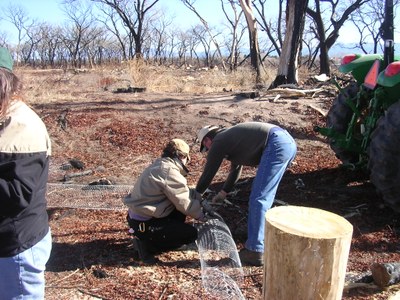Working With Volunteers
The amount of work to be done in the wake of a disaster can be daunting, and with wildfire, recovery often takes years of work. Volunteers can help your community recover from wildfire by carrying out the projects you do not have allocated resources for. Here is a list of tips and suggestions to aid you in successfully utilizing volunteer help.
1. Identify a Volunteer Coordinator: This should be someone personable and organized, with prior management experience. Your coordinator can take a lead in:
- Handling volunteer requests

- Handling volunteer offers and screening volunteers
- Creating and maintaining the volunteer database
- Tracking of volunteers, services and donations
- Matching the right volunteer with the right project
- Reviewing project proposals
- Researching and obtaining funding and resources for projects
- Recruiting volunteers through social media, press releases, and outreach opportunities, if needed.
2. Assess Resources: Working with the skills and the tasks you have identified for your community, ask yourself the following questions:
- What jobs need to be done that we do not have the resources for?
- What tasks can be done by volunteers?
3. Recruit Volunteers: Typically, volunteers with the following skills will be needed:
-
Patient, kind, knowledgeable people to answer telephones
-
Well-organized and detail-oriented people to handle volunteer applications, enter information into computer databases, and make follow-up calls
-
People willing to get dirty (cleanup, filling sandbags, raking, seeding and related activities). When working with volunteers on physical jobs, safety is paramount. Ensure people are properly trained, and keep groups small (about seven people with each volunteer leader; the leader should be trained in the work you are implementing and have very brief written instructions on the task at hand). Keep instructions simple and clear for hands-on work.
-
Seasoned and strong outdoor types who can lift and place heavy wattles, logs or bales of straw
-
People with professional skills such as grant writing, accounting, legal skills, and media and outreach skills
4. Motivate volunteers, but keep them from going "overboard": volunteers can injure themselves or experience overwhelm or fatigue. Monitor volunteer well-being to avoid dangerous situations.
5. Have a plan for addressing liability and injury issues. This includes the creation of a volunteer waiver and release of liability forms. These forms can also include a volunteer or work agreement to help ensure your projects get completed.
6. Find Tasks for People Who Want To Help: If possible, rather than turn away someone who wants to volunteer, try to find the right job for that person. Allowing community members to pitch in and help out not only provides needed labor but can also promote community cohesion and advance their personal healing process. To help match volunteers with needs, use online resources such as recovers.org.
6. Maintain a Volunteer Database: Developing a volunteer database is an important step. Each project and community will require different information, but at a minimum should include:
- First Name, Last Name (or name of organization and primary contact)
- Address, City, County, State, Zip Code
- Work Phone and extension, Home Phone, Mobile Phone
- Email Address
- Date of Birth (or adult or minor)
- Skills/Type of work volunteer is willing to perform and any relevant experience or expertise
- Availability
